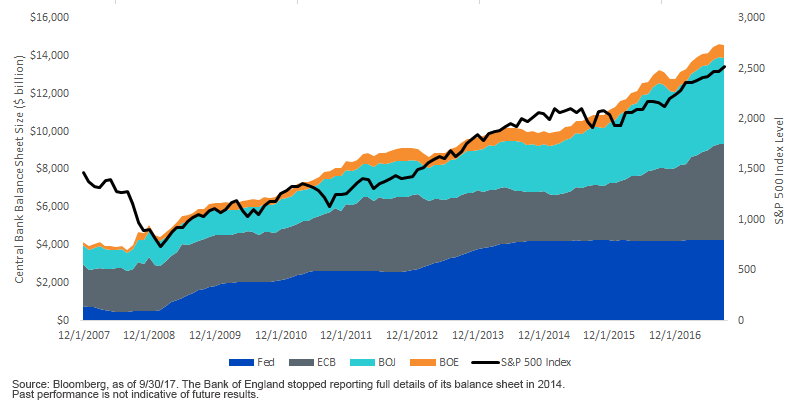The ECB: Moving the Goalposts or Real Tapering?



Is the “normalizing monetary policy musical chairs” trend now moving in the European Central Bank’s (ECB) direction? The Federal Reserve (Fed) started the process in December 2015 by beginning to remove their zero interest rate policy and, more recently, took the next step in the process: paring down their balance sheet starting in October. The Bank of Canada joined the rate-hike party in July, while the Bank of England is widely expected to follow suit at one of their remaining two policy meetings in 2017. All eyes within the global financial markets are now on the ECB, and the question becomes: Is the result of the ECB's recent meeting the beginning of their normalizing process (tapering) or just an adjustment to their existing bond buying program (moving the goalposts)?
Heading into the most recent ECB convocation, comparisons were being made to the Fed’s Ben Bernanke-induced taper tantrum here in the U.S. However, there are certainly a host of differences that stand out as the markets reacted to this announcement—namely, the level of the respective 10-Year yields. The U.S. Treasury 10-Year yield pre-taper tantrum in 2013 was 1.93%, while the German bund yield prior to the ECB’s latest meeting was .47%. Perhaps the biggest difference between these two episodes is that when former Fed Chair, Bernanke first spoke of possible tapering in May 2013, it was widely unexpected (thus the negative reaction), while the ECB’s decision was very much expected and became more a matter of what their tapering plan would look like, not whether it would scale back asset purchases.
Global Central Bank Balance Sheets

Prior to the October 26 meeting, the markets essentially were operating under three different possible scenarios (the current pace of buying is €60 billion/month through December 2017):
1. Pace reduced to €40 billion/month through December 2018.
2. Pace reduced to €30 billion/month through September 2018.
3. Pace reduced to €20 billion/month through June 2018.
Scenario #1 was expected to be viewed as a dovish outcome, with the 10-year bund yield either remaining unchanged or falling; Scenario #2 was viewed as more of a neutral event, with the 10-year bund being little changed; Scenario #3 was expected to be a hawkish development and the 10-year bund would sell off. In our opinion, the bottom line message is that despite this ECB decision, global central bank balance sheets (Fed included) are going to remain bloated for the foreseeable future, and in the case of the eurozone, this trend will continue to expand into next year.
In the end, the ECB decided on Scenario #2. Interestingly, the global bond markets went into the meeting expecting a bit more of a hawkish outcome. As a result, there was some knee-jerk buying in the German bund, but that was more of a relief rally. In addition, much like the Fed prior to its reinvestment pay-down plan, the ECB stated it will reinvest maturing debt for an extended period after quantitative easing (QE).
Thus, in aggregate, global balance sheets in the developed world for the four major central banks are still expanding, an important factor driving the appreciation of global equity markets. The quantitative tightening by the Fed continues to be more than offset by an expansion in the monetary base in Europe and Japan. Although the euro lost value in the immediate reaction versus the dollar and the yen, it will be interesting to see if the euro's impressive appreciation in 2017 versus the yen continues into 2018. European yields could begin to inch back up as U.S. rates creep higher. Given that the Bank of Japan (BOJ) is still pursuing its policy to suppress yields on Japanese government bonds, foreign bond purchases may become increasingly attractive to Japanese institutional investors. If the dollar and the euro appreciate relative to the yen, that could create advantages for Japanese exporters selling into Europe and for U.S. investors who invest in Japanese stocks.
Conclusion
The initial reaction for the U.S. dollar was to strengthen a bit versus the euro, as the worst fears were not realized. With respect to the yen, continued euro strengthening relative to the yen could be an additional catalyst for the bull market in Japanese stocks.



